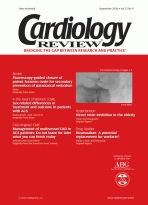Publication
Article
Cardiology Review® Online
End-stage renal disease and ARVD: Where goes the trend?
Author(s):
The incidence of end-stage renal disease (ESRD) has nearly doubled in the United States between 1991 and 2000 and has been projected to increase by 50% by 2015.
The incidence of end-stage renal disease (ESRD) has nearly doubled in the United States between 1991 and 2000 and has been projected to increase by 50% by 2015. More than a decade ago, Mailloux et al reported that arteriosclerotic renovascular disease (ARVD) in their dialysis population (at a rate of 12.2%) was associated with higher mortality rates.1 As life expectancy increases worldwide, the number of patients starting dialysis should progressively increase, along with the incidence of ARVD and mortality rates. Foley et al's study was designed to estimate the annual trends in the proportion of ≥ 67-year-old patients starting dialysis with ARVD from 1996 to 2000.
This study used the United States Data System (USRDS) database as the primary data source, which was linked to Medicare claims indicating ARVD and renal revascularization 2 years before initiating dialysis. The proportion of patients with ARVD increased from 7.1% in 1996 to 11.2% in 2001 but was listed at 5.2% as a primary cause of ESRD at the time of initiation of dialysis for both years. Revascularization was performed in 16.2% of patients with ARVD and was more commonly performed in 2001, although as in the case of ARVD diagnosis, there was a great deal of geographic variation. Arteriosclerotic renovascular disease was a temporally antecedent association of atherosclerotic heart disease (adjusted hazard ratio [AHR], 1.28), congestive heart failure (AHR, 1.12), cerebrovascular accident/transient ischemic attacks (AHR, 1.20) and peripheral vascular disease (AHR, 1.56) and those undergoing revascularization procedures had lower mortality rates.
This study supports the intuitive conclusion that vascular disease increases with advancing age. It suffers from being a retrospective analysis of the USRDS data that relies on diagnoses based on uncontrolled physician input. The assumption is that the diagnosis of ARVD is based largely on the degree of stenosis of one or both renal arteries, although renovascular disease can involve smaller arteries in the renal vasculature without significant stenosis. What are the criteria by which ARVD is made? Does 50% stenosis of a renal artery establish the diagnosis of ARVD? How was the diagnosis of ARVD established—by renal angiography, Doppler studies, magnetic resonance angiography, or other methods? These ambiguities raise question on the validity of the ARVD diagnosis reported to USRDS.
There was an increase in the proportion of patients with ARVD between 1996 and 2001. This increase in ARVD in patients ≥ 67 years probably does not represent an increase in ARVD in the same population but rather an increase in the average age of patients undergoing dialysis in 2001 as compared to 1996, and possibly an increase in awareness of ARVD among physicians and improvement in our diagnostic armamentarium. This perspective is supported by the fact that the primary cause of ESRD attributed to ARVD did not change between these years despite the increase in the increased overall diagnosis of ARVD.
Moreover, uniformity of data gathering must also consider the method of diagnosis of ARVD and the diagnostic criteria for making the diagnosis of ARVD. The geographic variations noted in this study may represent both the geographical differences in risk factors of ARVD, ie, hypercholesterolemia, smoking habits, diabetes, and other medical risk factors of atherosclerosis, as well as the different approaches used to diagnose renovascular diseases. Diagnostic screening of ARVD has improved with the wider availability of magnetic resonance angiography in recent years. This may have contributed to the increased incidence of diagnosis.
This trend may soon reverse as recent concerns have arisen over gadolinium-induced nephrogenic fibrosing dermopathy (NFD) in advanced kidney disease patients. The FDA has recently issued a public health advisory on gadolinium use and the possible development of NFD, which can lead to progressive dermis thickening, hardening of the skin, and eventual physical disability.2 Renal-artery Doppler is highly operator dependent, especially in less experienced diagnostic centers, and this change to diagnostic methodology may alter the future diagnostic trend.
As noted by the authors, accurate attribution of the cause of ESRD is often difficult, especially in the setting of multiple comorbidities and disease risks. Expectedly, patients with prior diagnosis of ARVD were more likely to have renovascular disease listed as the primary cause of ESRD.






